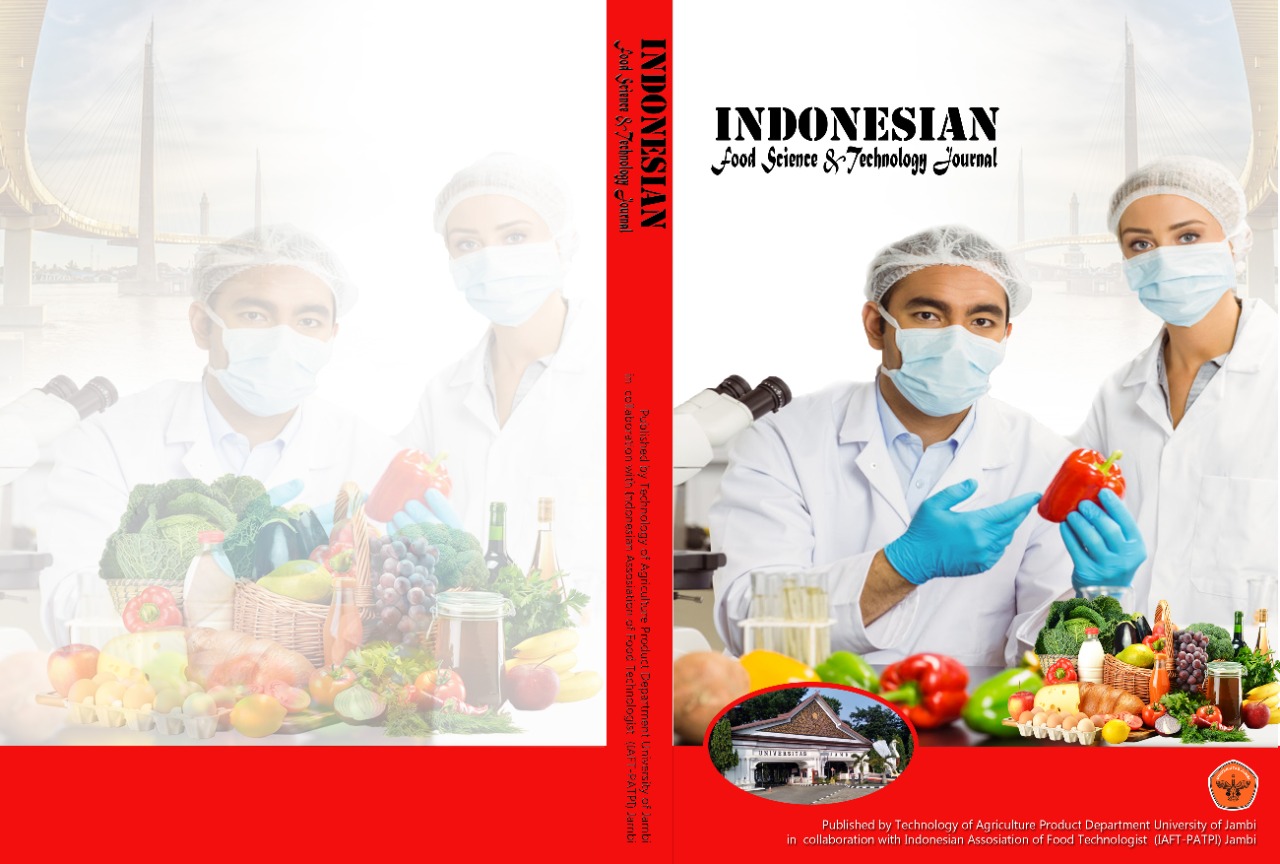The Quality of Lokan (Geloina erosa ) Rendang Oil Substituted with Red Palm Oil Olein
DOI:
https://doi.org/10.22437/ifstj.v7i1.29764Keywords:
Antioxidant Activity; Red Palm Oil Olein; Rendang; SubstituteAbstract
Rendang is a typical Minangkabau cuisine in West Sumatra, which is usually made with beef and other protein resources such as Lokan, which contains amino acids L-leucine and L-isoleucine. It is made with coconut milk that produces oil during cooking. The oil can be substituted with Red Palm Oil Olein (RPOO), which contains nutrients essential for the body as antioxidants. This study aims to determine the effect of RPOO substitution in Lokan rendang on color properties, vitamin A content, antioxidant activity, and organoleptic properties. A Completely Randomized Experimental Design (CRD) with one factor and five treatment levels was used in this study. Â The treatment factor was RPOO substitution with 0, 25, 50, 75, and 100% Lokan rendang oil. Each treatment was repeated three times resulting in 15 experimental runs. The data of vitamin A and antioxidant activity were analyzed using ANOVA followed by LSD, whereas sensory data were analyzed using the Friedman Ranking Test. The result showed that RPOO substitution significantly affected the antioxidant activity and organoleptic properties (taste, aroma, and overall) of rendang Lokan. The greater the substituted RPOO, the greater the vitamin A content in Lokan rendang. The substitution of 50% oil in rendang lokan with RPOO Â Â improved provitamin A and antioxidant activity significantly without disrupting the acceptability its sensory values. Therefore, the 50% substitution of rendang lokan oil can be utilized to fortify vitamin A.
Downloads
References
Rini, F. Azima, K. Sayuti, and Novelina, “The Evaluation of Nutritional Value of Rendang Minangkabau,†Agric. Agric. Sci. Procedia, vol. 9, pp. 335–341, 2016, doi: 10.1016/j.aaspro.2016.02.146.
M. Nurmufida, G. H. Wangrimen, R. Reinalta, and K. Leonardi, “Rendang: The treasure of Minangkabau,†J. Ethn. Foods, vol. 4, no. 4, pp. 232–235, 2017, doi: 10.1016/j.jef.2017.10.005.
S. Fatimah, D. Syafrini, Wasino, and R. Zainul, “Rendang lokan: history, symbol of cultural identity, and food adaptation of Minangkabau tribe in West Sumatra, Indonesia,†J. Ethn. Foods, vol. 8, no. 1, 2021, doi: 10.1186/s42779-021-00088-2.
N. A. Zarim, S. Zainul Abidin, and F. Ariffin, “Shelf life stability and quality study of texture-modified chicken rendang using xanthan gum as thickener for the consumption of the elderly with dysphagia,†Food Biosci., vol. 42, no. March, pp. 1–10, 2021, doi: 10.1016/j.fbio.2021.101054.
A. K. Nadra and E. Nora, “Rendang Lokan as A Culinary Tourism Attraction in Pesisir Selatan,†J. Bus. Hosp. Tour., vol. 6, no. 2, pp. 401–407, 2020, doi: 10.22334/jbhost.v6i2.259.
L. Agustina, B. Budiyanto, and T. Tutuarima, “Subtitusion of Rpo To Seasoning Oil and Acceptability and Fortification Potency of Vitamin a Trough Chicken Noodle,†J. Agroindustri, vol. 8, no. 2, pp. 150–158, 2019, doi: 10.31186/j.agroind.8.2.150-158.
M. Yupita, B. Budiyanto, and H. Koto, “Substitution of Red Palm Oil Olein ( RPOO ) as a Source of Provitamin E in Grilled Meatball Sauce,†AGRITROPICA J. Agric. Sci., pp. 13–21, 2022, [Online]. Available: https://ejournal.unib.ac.id/index.php/jagritropica/index
L. Nofita, Budiyanto, and F. E. D. Surawan, “Pengaruh Subtitusi Fraksi Olein Minyak Sawit Merah pada Bumbu Kacang Batagor terhadap Karakteristik Fisik , Sensoris,†J. Teknol. Agro-industri, vol. 7, no. 2, pp. 132–146, 2020.
M. Perez-Santana, G. B. Cagampang, L. Gu, I. S. MacIntosh, S. S. Percival, and A. J. MacIntosh, “Characterization of physical properties and retention of bioactive compounds in cookies made with high oleic red palm olein,†Lwt, vol. 147, no. November 2020, p. 111499, 2021, doi: 10.1016/j.lwt.2021.111499.
B. Budiyanto, D. Silsia, and A. Napitupulu, “Alternatif Fortification Vitamin A for Lactating Mother Using Siomay Sauce Enriched with Red Palm Oil,†AGRITROPICA J. Agric. Sci., vol. 2, no. 1, pp. 13–25, 2019, doi: 10.31186/j.agritropica.2.1.13-25.
S. Alkandari et al., “Pilot scale production of functional foods using red palm olein: Antioxidant, vitamins’ stability and sensory quality during storage,†Saudi J. Biol. Sci., vol. 28, no. 10, pp. 5547–5554, Oct. 2021, doi: 10.1016/j.sjbs.2021.06.032.
W. Iftari, R. Amalia, A. N. Savitri, and G. Saragih, “Study of The Addition of Red Palm Oil (RPO) to The Sensory and Chemical Characteristics of Beef Sausage,†J. Pangan dan Agroindustri, vol. 10, no. 4, pp. 194–203, 2022.
M. Abd- ElGhany, A. Hegazy, A. Basuny, and A. Zaghlool, “Using of red palm oil as milk fat healthy replacer in ice milk,†Al-Azhar J. Agric. Res., vol. 45, no. 1, pp. 8–22, 2020, doi: 10.21608/ajar.2020.126614.
W. J. Lee, C. P. Tan, R. Sulaiman, Y. Y. Hee, and G. H. Chong, “Storage stability and degradation kinetics of bioactive compounds in red palm oil microcapsules produced with solution-enhanced dispersion by supercritical carbon dioxide: A comparison with the spray-drying method,†Food Chem., vol. 304, pp. 1–11, 2020, doi: 10.1016/j.foodchem.2019.125427.
W. Haliza and N. Harimurti, “The functionality characteristic of the different formulas of nano-emulsion containing temulawak-red palm oil extract,†IOP Conf. Ser. Earth Environ. Sci., vol. 1024, no. 1, 2022, doi: 10.1088/1755-1315/1024/1/012070.
J. Ferguson, “Color Name Diagrams for the Munsell Color Charts for Plant Tissues,†Univ. Toronto Canada, 2012.
U.S Institut Of Medicine, Dietary reference intakes for vitamin A, vitamin K, arsenic, boron, chromium, copper, iodine, iron, manganese, molybdenum, nickel, silicon, vanadium, and zinc. Washington DC: National Academy Press, 2002.
B. J. Burri, “Evaluating Global Barriers to the Use of Red Palm Oil as an Intervention Food to Prevent Vitamin A Deficiency,†Compr. Rev. Food Sci. Food Saf., vol. 11, no. 2, pp. 221–232, 2012, doi: 10.1111/j.1541-4337.2011.00181.x.
A. Nizori, E. Jayanti, S. Surhaini, I. Gusriani, M. Mursyid, and D. T. Purba, “Influence of Fermentation Conditions on The Antioxidant and Physico-Chemical of Arabica Coffee from Kerinci Region of Indonesia,†Indones. Food Sci. Technol. J., vol. 5, no. 1, pp. 34–38, 2021, doi: 10.22437/ifstj.v5i1.17383.
R. Rachmaniar, H. Kartamihardja, and Merry, “Pemanfaatan Buah Jambu Biji Merah (Psidium guajava Linn.) Sebagai Antioksidan Dalam Bentuk Granul Effervescent,†JSTFI Indones. J. Pharm. Sci. Technol., vol. V, no. 1, 2016.
D. Setyaningsih, A. Apriyantono, and M. P. Sari, Analisis Sensori untuk Industri Pangan dan Agro. Bogor: IPB Press, 2010.
F. G. Winarno, Kimia Pangan dan Gizi. Bogor: M-Brio Press, 2008.
X. Wu, S. Wu, M. Ji, and J. H. Yoong, “Influence of red palm oil on the physicochemical and sensory qualities of flavouring oil gravy for instant noodles,†RSC Adv., vol. 8, no. 2, pp. 1148–1158, 2018, doi: 10.1039/c7ra12387f.
R. K. Saini, S. H. Nile, and S. W. Park, Carotenoids from fruits and vegetables: Chemistry, analysis, occurrence, bioavailability and biological activities, vol. 76. Elsevier B.V., 2015. doi: 10.1016/j.foodres.2015.07.047.
D. N. Yadav, S. Bansal, S. Tushir, J. Kaur, and K. Sharma, “Advantage of biofortification over fortification technologies,†in Wheat and Barley Grain Biofortification, New Delhi: Elsevier Inc., 2020, pp. 257–273. doi: 10.1016/B978-0-12-818444-8.00010-9.
O. Sommerburg et al., “Supplementation with Red Palm Oil Increases β -Carotene and Vitamin A Blood Levels in Patients with Cystic Fibrosis,†Mediators Inflamm., vol. 2015, 2015, doi: 10.1155/2015/817127.
L. Agustina, B. Budiyanto, and T. Tutuarima, “Subtitusion of Rpo To Seasoning Oil and Acceptability and Fortification Potency of Vitamin a Trough Chicken Noodle,†J. Agroindustri, vol. 8, no. 2, pp. 150–158, 2019, doi: 10.31186/j.agroind.8.2.150-158.
P. Molyneux, “The use of the stable free radical diphenylpicryl-hydrazyl (DPPH) for estimating antioxidant activity,†Songklanakarin J. Sci. Technol., vol. 26, no. 2, pp. 211–219, 2004.
J. Xu, Y. Y. Liu, T. M. Olajide, H. A. Liu, and X. C. Weng, “The effect of replacing red palm stearin with red palm olein in baked potato cookies,†Grasas y Aceites, vol. 73, no. 2, 2022, doi: 10.3989/GYA.0441211.
F. Abdullah, R. Ismail, R. Ghazali, and Z. Idris, “Total phenolic contents and antioxidant activity of palm oils and palm kernel oils at various refining processes,†J. Oil Palm Res., vol. 30, no. December, pp. 682–692, 2018, doi: 10.21894/jopr.2018.0058.
R. Loganathan, A. H. A. Tarmizi, S. R. Vethakkan, and K. T. Teng, “Thermal stability and sensory acceptance of cupcakes containing red palm olein,†J. Oleo Sci., vol. 69, no. 7, pp. 671–676, 2020, doi: 10.5650/jos.ess19253.
D. F. Ayu, S. Aminah, and A. Diharmi, “Photo-oxidation stability of mayonnaise from striped catfish and red palm mixture oil,†IOP Conf. Ser. Earth Environ. Sci., vol. 757, no. 1, 2021, doi: 10.1088/1755-1315/757/1/012052.
D. Elianarni, S. Raharjo, and S. Supriyadi, “Formulation and Characteristics of Red Palm Oil Nanostractured Lipid Carriers Prepared by Microemulsion Method and Its Application in Drinking Yoghurt,†Indones. Food Nutr. Prog., vol. 19, no. 1, pp. 1–8, 2022, doi: 10.22146/ifnp.70925.
W. Wirawan, S. Raharjo, and Supriyadi, “Formulation and Characteristics of Nanostuctured Lipid Carrier (NLC) Red Palm Oil (RPO) Prepared by High-Pressure Homogenization and Its Applications in Orange Juice,†Indones. Food Nutr. Prog., vol. 19, no. 1, pp. 31–40, 2022, doi: 10.22146/ifnp.70924.
Downloads
Published
How to Cite
Issue
Section
License
Copyright (c) 2023 Indonesian Food Science and Technology Journal

This work is licensed under a Creative Commons Attribution 4.0 International License.







